BHS101A Anatomy: Integumentary System, Homeostasis, and Function
VerifiedAdded on 2023/04/17
|12
|712
|386
Presentation
AI Summary
This presentation provides an overview of the integumentary system, including its structure, function, and role in homeostasis. It details the levels of organization from cells to the skin organ, the layers and cells of the epidermis (keratinocytes, melanocytes, Langerhans cells, Merkel cells, and the stratum layers), and the three layers of the skin. The presentation also covers other structures such as nails, hair, and glands, and explains the functions of the skin, including protection, sensation, temperature regulation, and blood reservoir. The integumentary system's role in temperature homeostasis and protection against pathogens and radiation is emphasized, along with its provision of sensory information. The presentation concludes that the integumentary system is crucial for well-functioning life processes.

The integumentary System
Subject : Anatomy and Physiology
Assessment 2
Lecturer’s name :
Student name :
Subject : Anatomy and Physiology
Assessment 2
Lecturer’s name :
Student name :
Paraphrase This Document
Need a fresh take? Get an instant paraphrase of this document with our AI Paraphraser

Introduction :
Figure 5 :
Integumentary
system (Rizzo,
2012, p.119)
Figure 5 :
Integumentary
system (Rizzo,
2012, p.119)
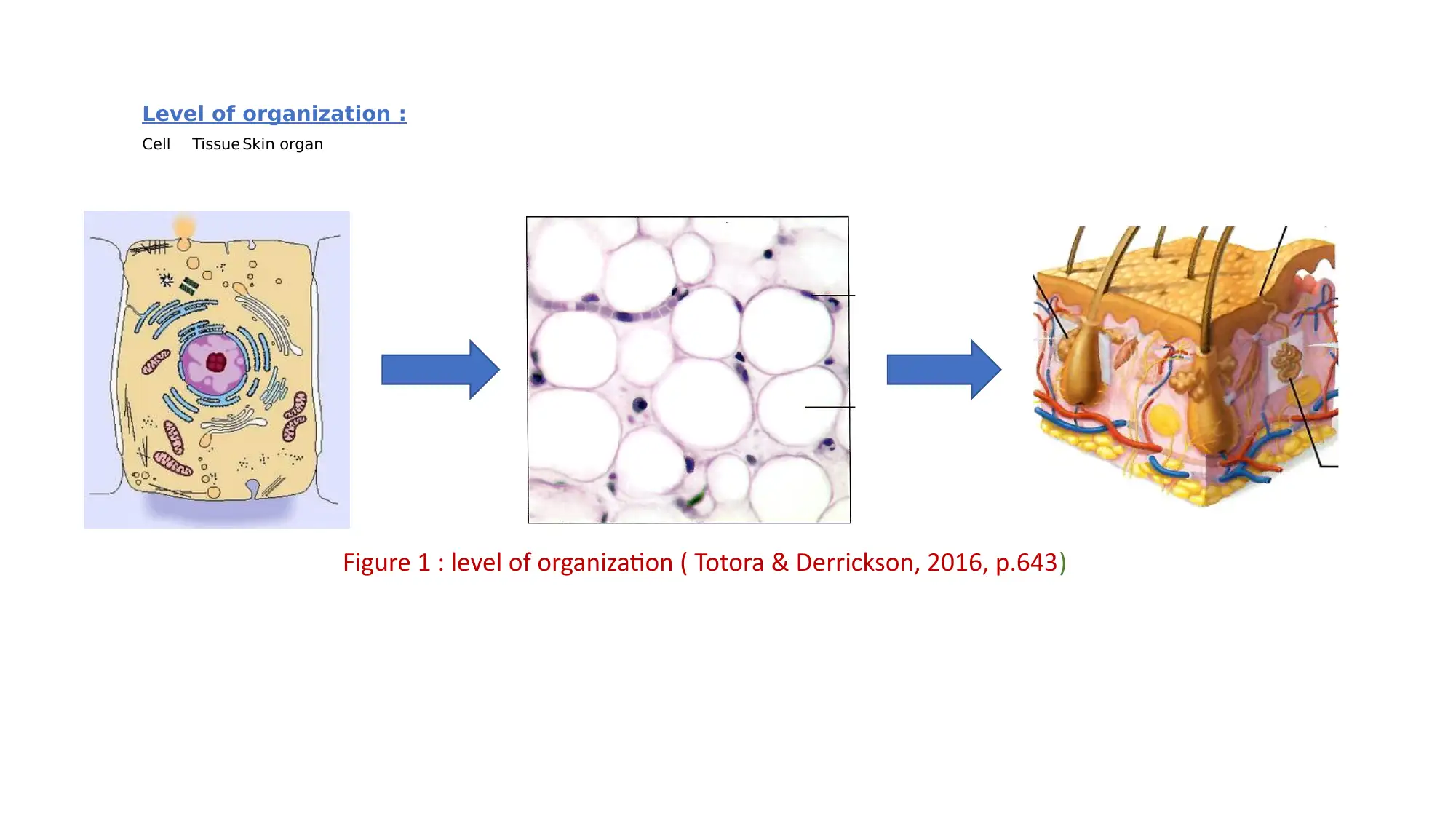
Level of organization :
Cell Tissue Skin organ
Figure 1 : level of organization ( Totora & Derrickson, 2016, p.643)
Cell Tissue Skin organ
Figure 1 : level of organization ( Totora & Derrickson, 2016, p.643)
⊘ This is a preview!⊘
Do you want full access?
Subscribe today to unlock all pages.

Trusted by 1+ million students worldwide
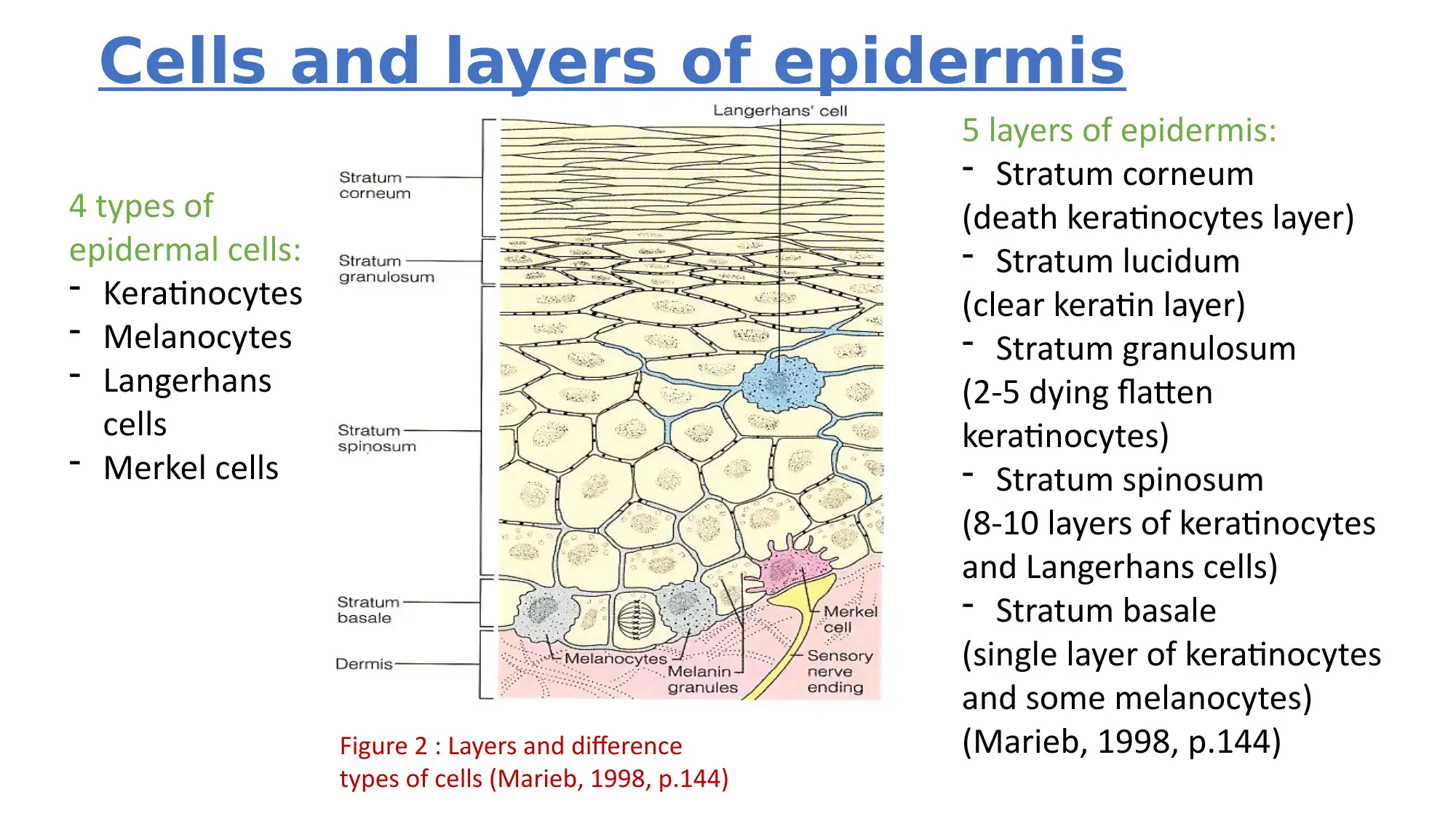
Cells and layers of epidermis
4 types of
epidermal cells:
- Keratinocytes
- Melanocytes
- Langerhans
cells
- Merkel cells
5 layers of epidermis:
- Stratum corneum
(death keratinocytes layer)
- Stratum lucidum
(clear keratin layer)
- Stratum granulosum
(2-5 dying flatten
keratinocytes)
- Stratum spinosum
(8-10 layers of keratinocytes
and Langerhans cells)
- Stratum basale
(single layer of keratinocytes
and some melanocytes)
(Marieb, 1998, p.144)Figure 2 : Layers and difference
types of cells (Marieb, 1998, p.144)
4 types of
epidermal cells:
- Keratinocytes
- Melanocytes
- Langerhans
cells
- Merkel cells
5 layers of epidermis:
- Stratum corneum
(death keratinocytes layer)
- Stratum lucidum
(clear keratin layer)
- Stratum granulosum
(2-5 dying flatten
keratinocytes)
- Stratum spinosum
(8-10 layers of keratinocytes
and Langerhans cells)
- Stratum basale
(single layer of keratinocytes
and some melanocytes)
(Marieb, 1998, p.144)Figure 2 : Layers and difference
types of cells (Marieb, 1998, p.144)
Paraphrase This Document
Need a fresh take? Get an instant paraphrase of this document with our AI Paraphraser
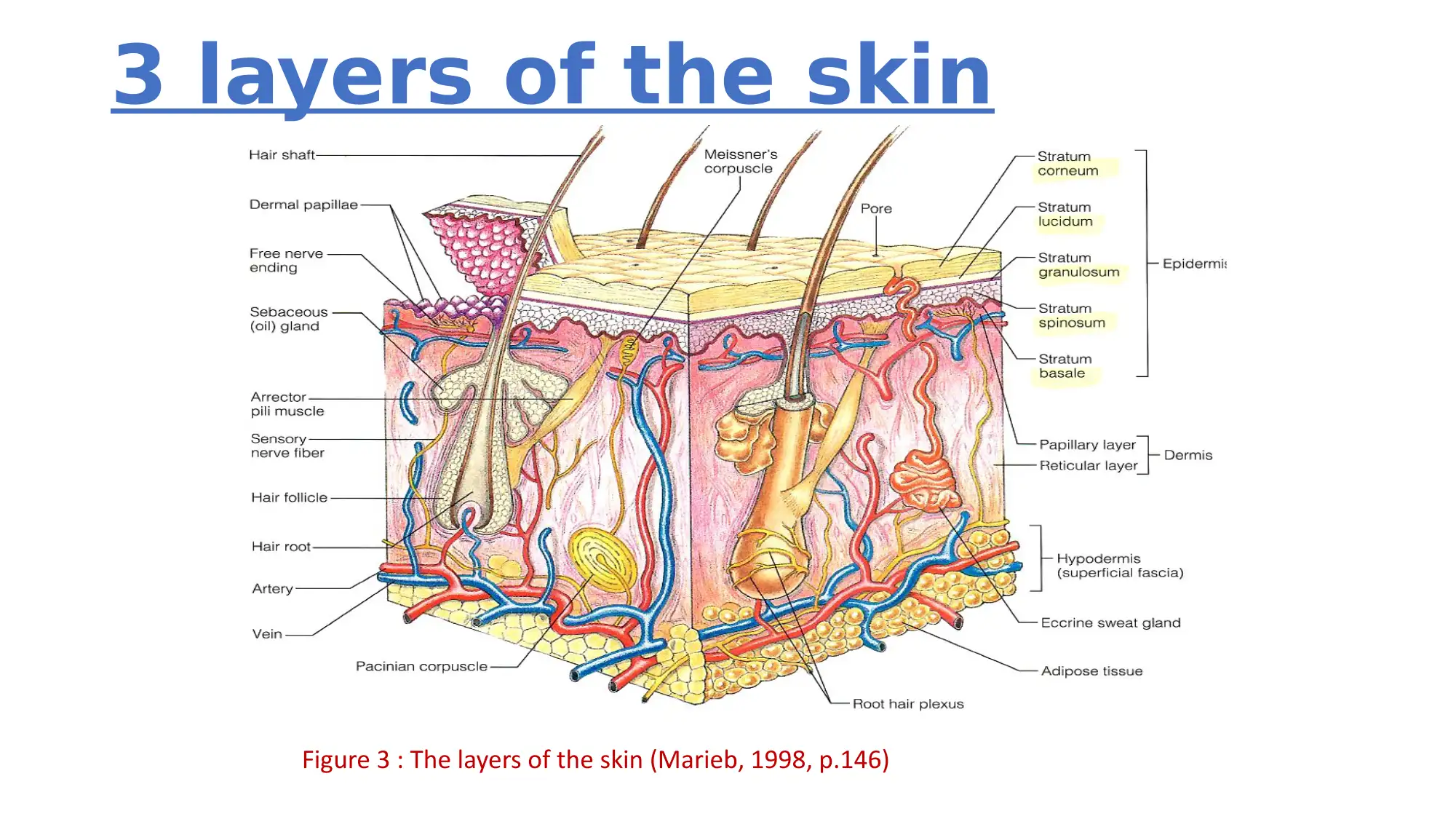
3 layers of the skin
Figure 3 : The layers of the skin (Marieb, 1998, p.146)
Figure 3 : The layers of the skin (Marieb, 1998, p.146)
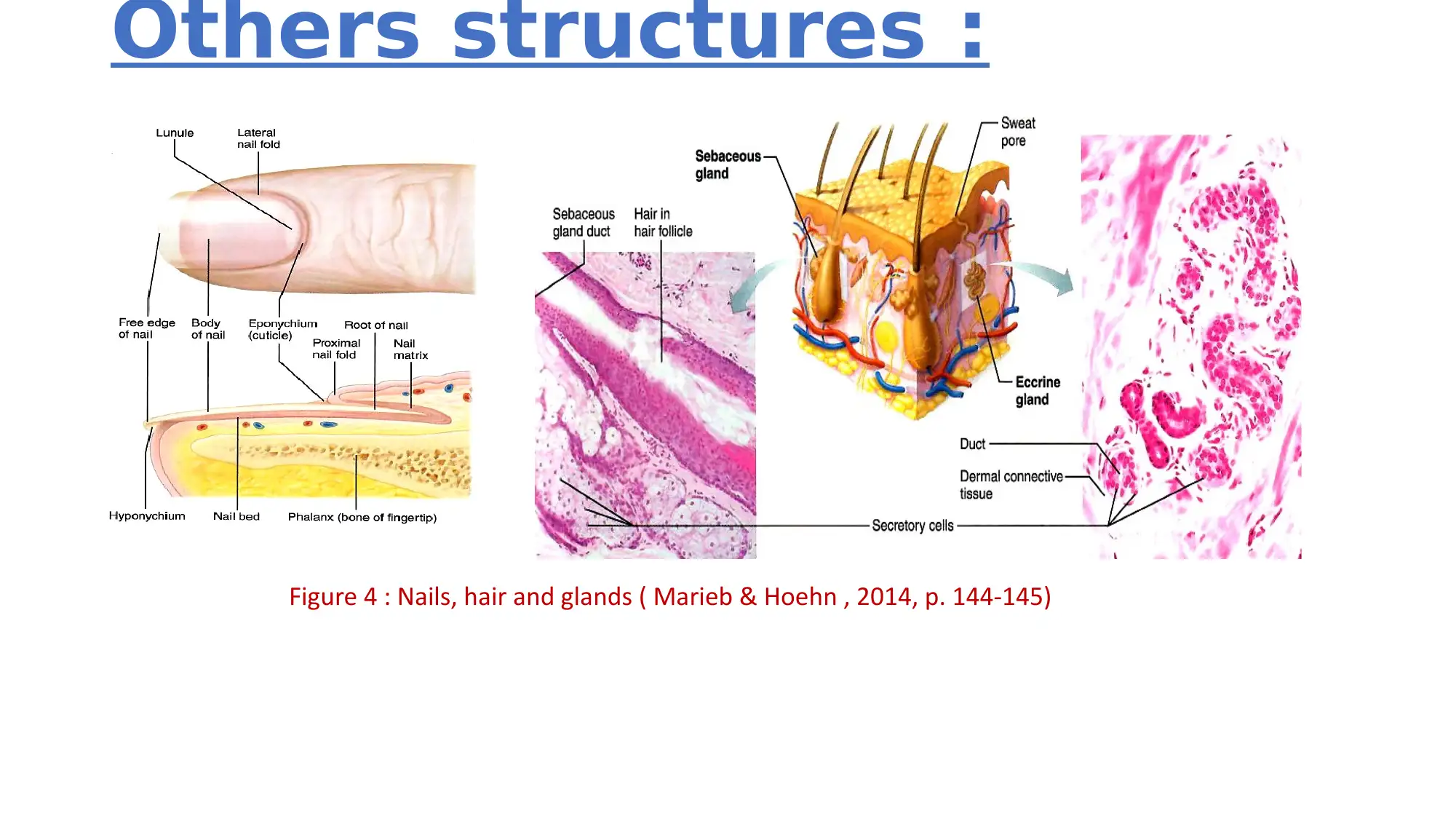
Others structures :
Figure 4 : Nails, hair and glands ( Marieb & Hoehn , 2014, p. 144-145)
Figure 4 : Nails, hair and glands ( Marieb & Hoehn , 2014, p. 144-145)
⊘ This is a preview!⊘
Do you want full access?
Subscribe today to unlock all pages.

Trusted by 1+ million students worldwide
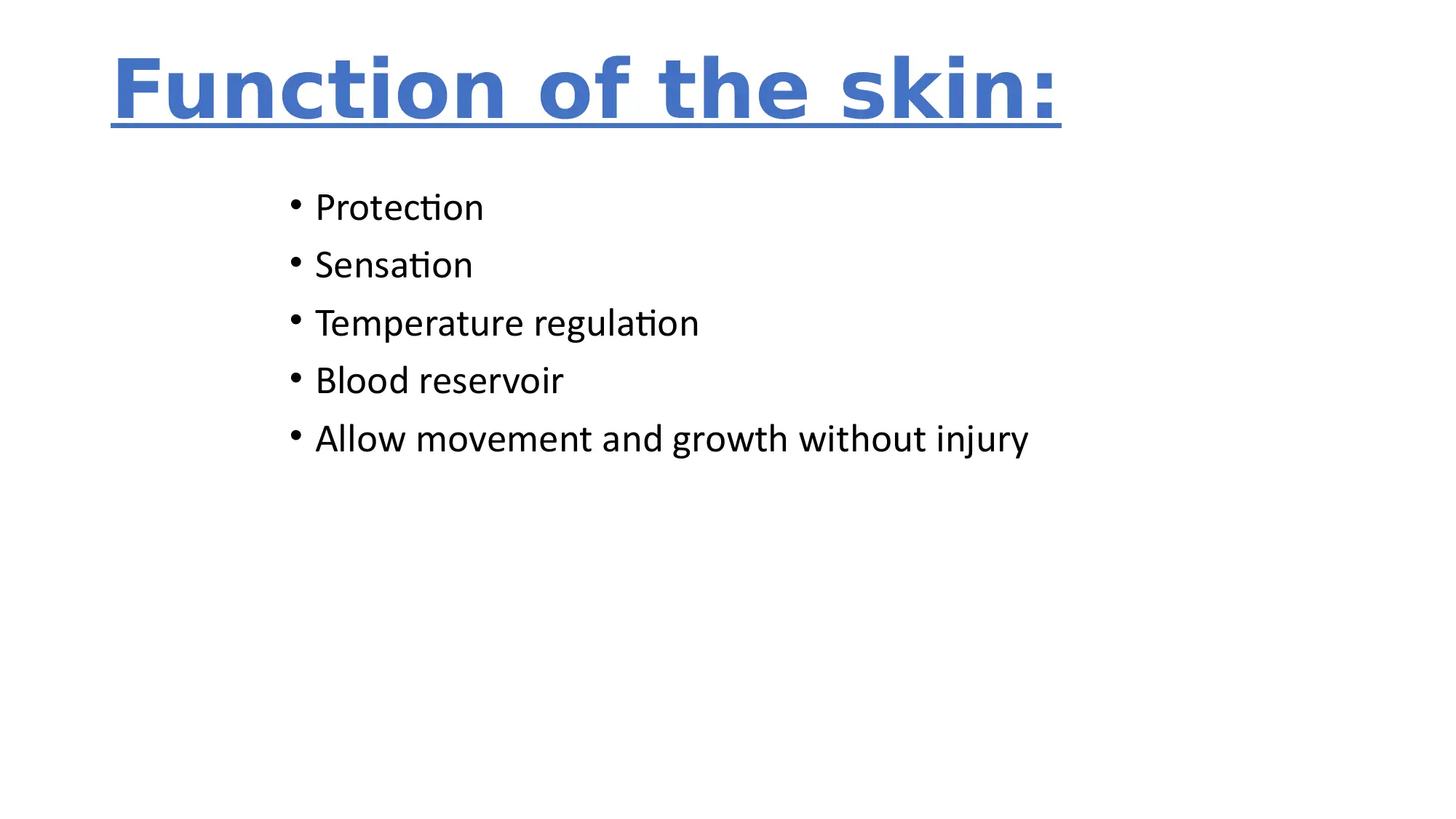
Function of the skin:
• Protection
• Sensation
• Temperature regulation
• Blood reservoir
• Allow movement and growth without injury
• Protection
• Sensation
• Temperature regulation
• Blood reservoir
• Allow movement and growth without injury
Paraphrase This Document
Need a fresh take? Get an instant paraphrase of this document with our AI Paraphraser
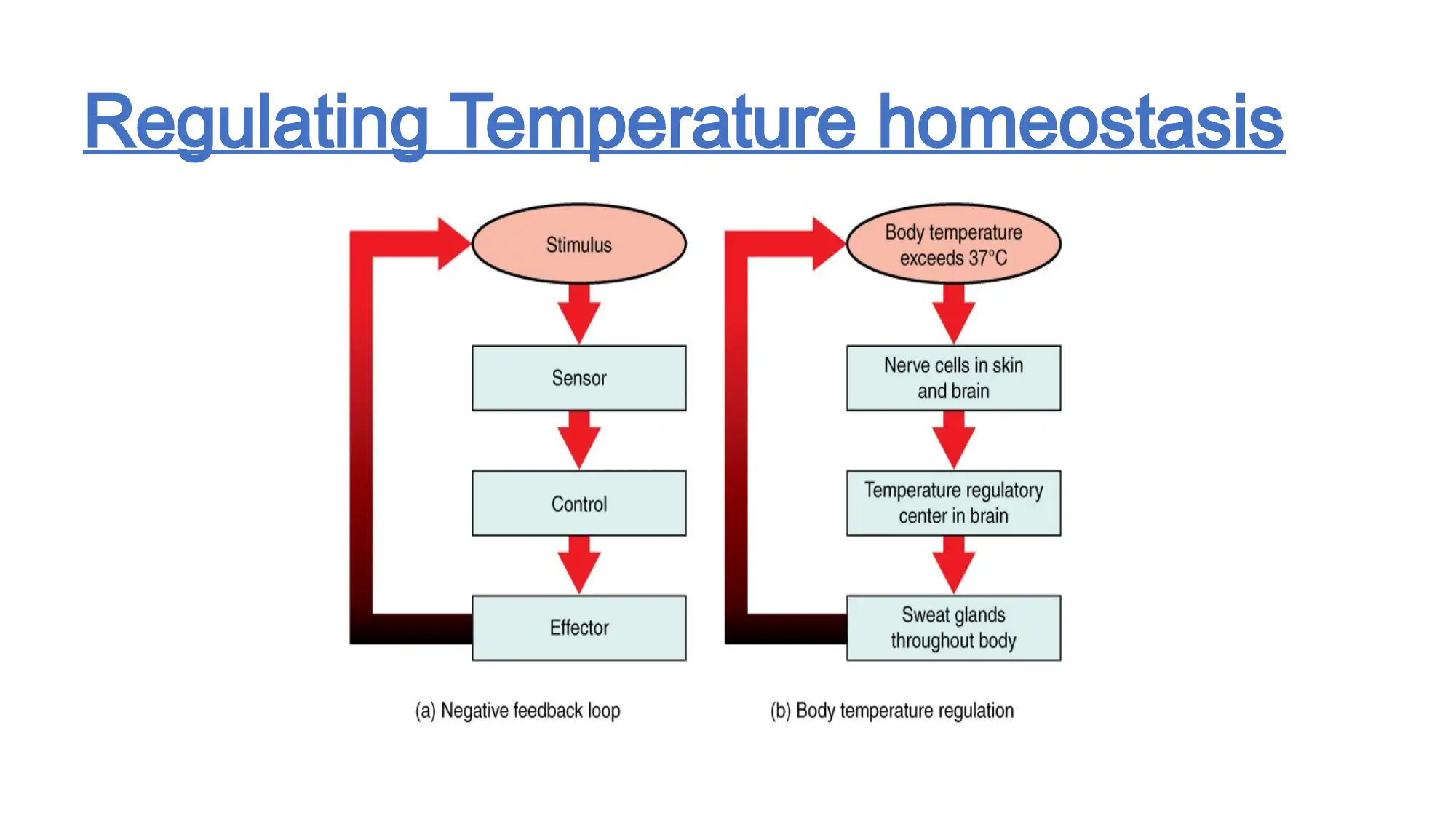
Regulating Temperature homeostasis
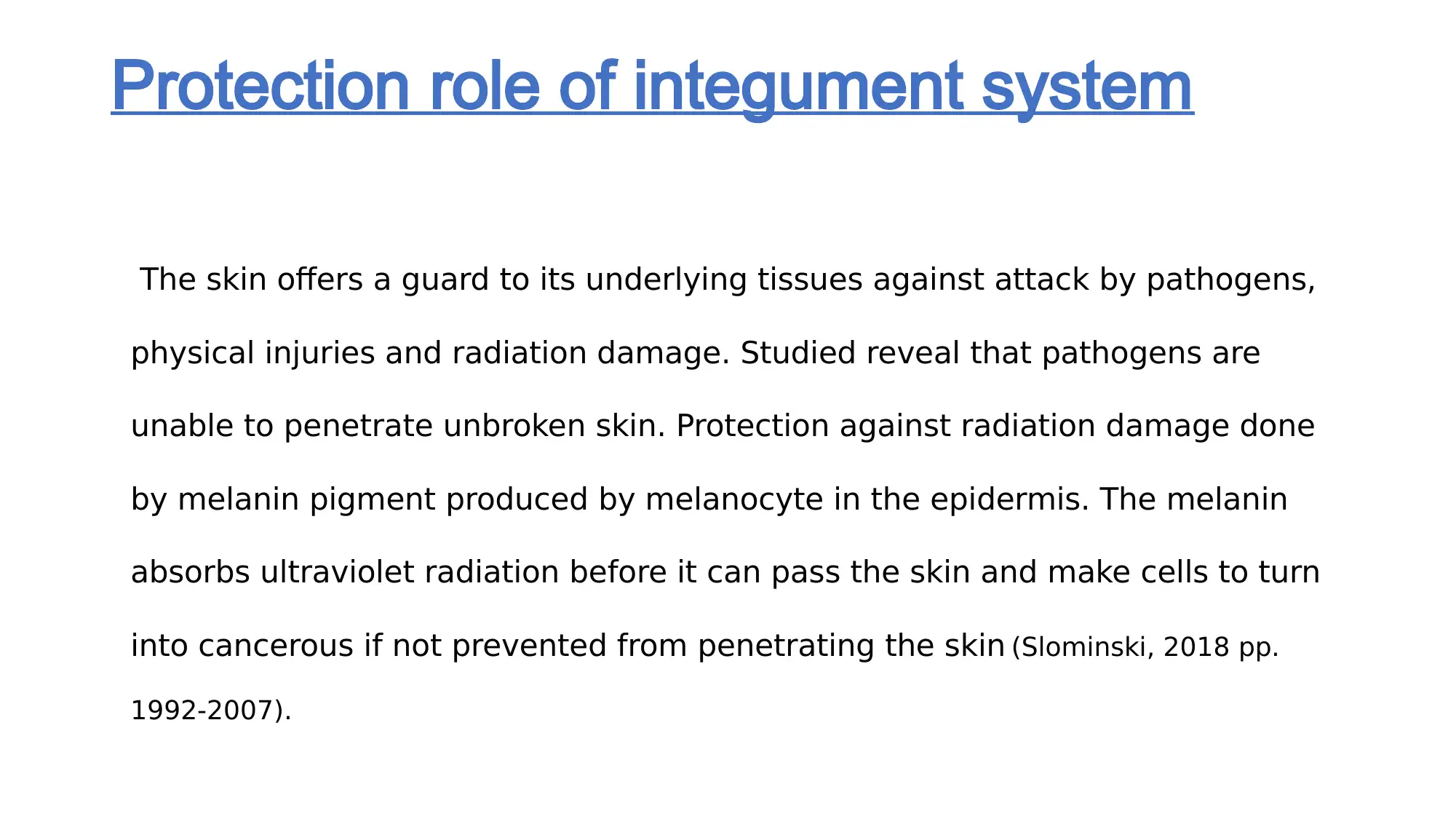
Protection role of integument system
The skin offers a guard to its underlying tissues against attack by pathogens,
physical injuries and radiation damage. Studied reveal that pathogens are
unable to penetrate unbroken skin. Protection against radiation damage done
by melanin pigment produced by melanocyte in the epidermis. The melanin
absorbs ultraviolet radiation before it can pass the skin and make cells to turn
into cancerous if not prevented from penetrating the skin (Slominski, 2018 pp.
1992-2007).
The skin offers a guard to its underlying tissues against attack by pathogens,
physical injuries and radiation damage. Studied reveal that pathogens are
unable to penetrate unbroken skin. Protection against radiation damage done
by melanin pigment produced by melanocyte in the epidermis. The melanin
absorbs ultraviolet radiation before it can pass the skin and make cells to turn
into cancerous if not prevented from penetrating the skin (Slominski, 2018 pp.
1992-2007).
⊘ This is a preview!⊘
Do you want full access?
Subscribe today to unlock all pages.

Trusted by 1+ million students worldwide
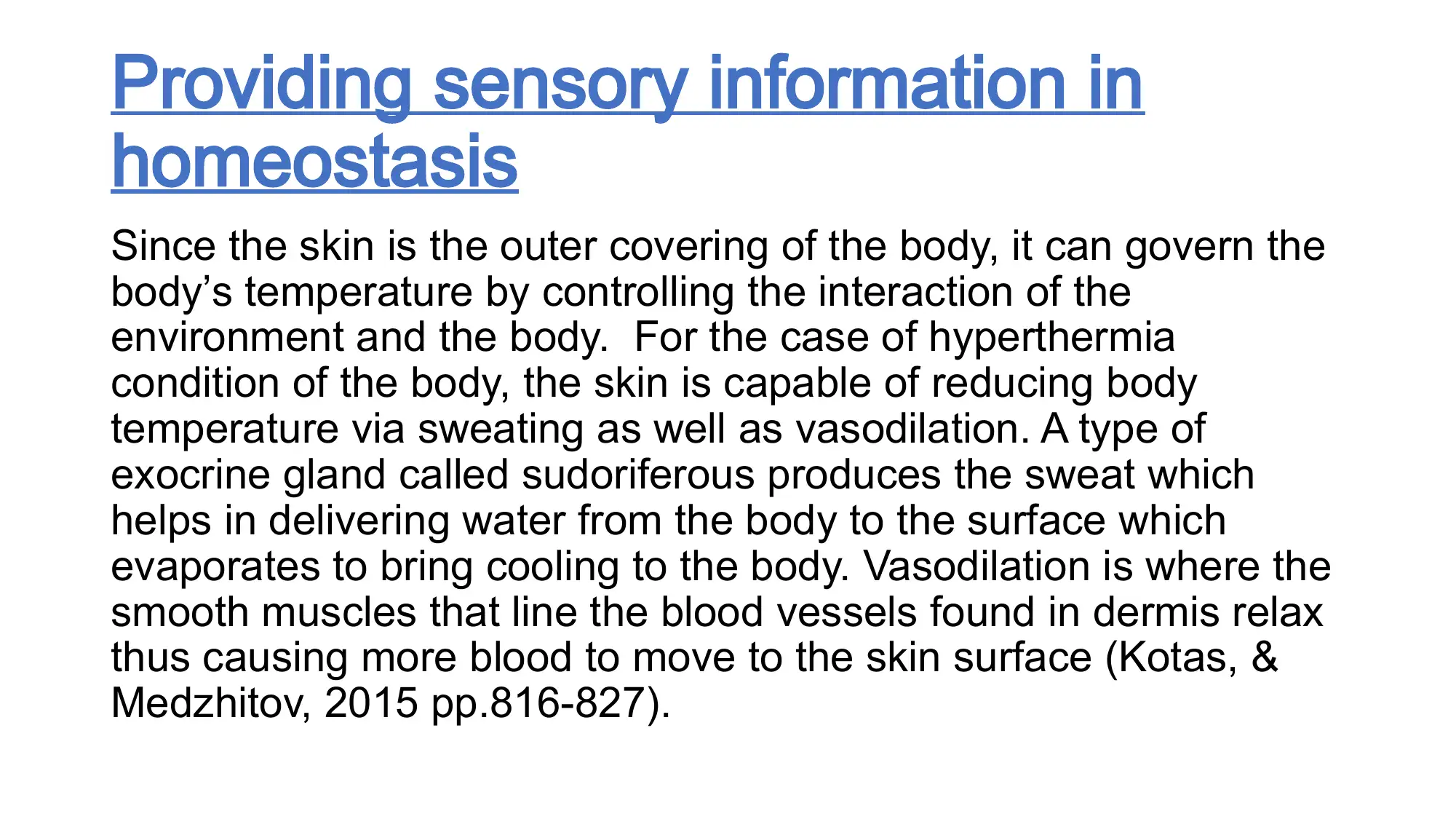
Providing sensory information in
homeostasis
Since the skin is the outer covering of the body, it can govern the
body’s temperature by controlling the interaction of the
environment and the body. For the case of hyperthermia
condition of the body, the skin is capable of reducing body
temperature via sweating as well as vasodilation. A type of
exocrine gland called sudoriferous produces the sweat which
helps in delivering water from the body to the surface which
evaporates to bring cooling to the body. Vasodilation is where the
smooth muscles that line the blood vessels found in dermis relax
thus causing more blood to move to the skin surface (Kotas, &
Medzhitov, 2015 pp.816-827).
homeostasis
Since the skin is the outer covering of the body, it can govern the
body’s temperature by controlling the interaction of the
environment and the body. For the case of hyperthermia
condition of the body, the skin is capable of reducing body
temperature via sweating as well as vasodilation. A type of
exocrine gland called sudoriferous produces the sweat which
helps in delivering water from the body to the surface which
evaporates to bring cooling to the body. Vasodilation is where the
smooth muscles that line the blood vessels found in dermis relax
thus causing more blood to move to the skin surface (Kotas, &
Medzhitov, 2015 pp.816-827).
Paraphrase This Document
Need a fresh take? Get an instant paraphrase of this document with our AI Paraphraser

Conclusion
Integument system is one among many body systems that play a key role in the well-
functioning life process. The paper has expounded more on what the integument
comprises of and further details on each component based on anatomy and physiology.
The element discussed are the skin, hair, nails, sweet and oil glands. Additionally the
role of integument on homeostasis that is how it helps to relate body temperature as
well as protection role against several environmental hazards.
Integument system is one among many body systems that play a key role in the well-
functioning life process. The paper has expounded more on what the integument
comprises of and further details on each component based on anatomy and physiology.
The element discussed are the skin, hair, nails, sweet and oil glands. Additionally the
role of integument on homeostasis that is how it helps to relate body temperature as
well as protection role against several environmental hazards.
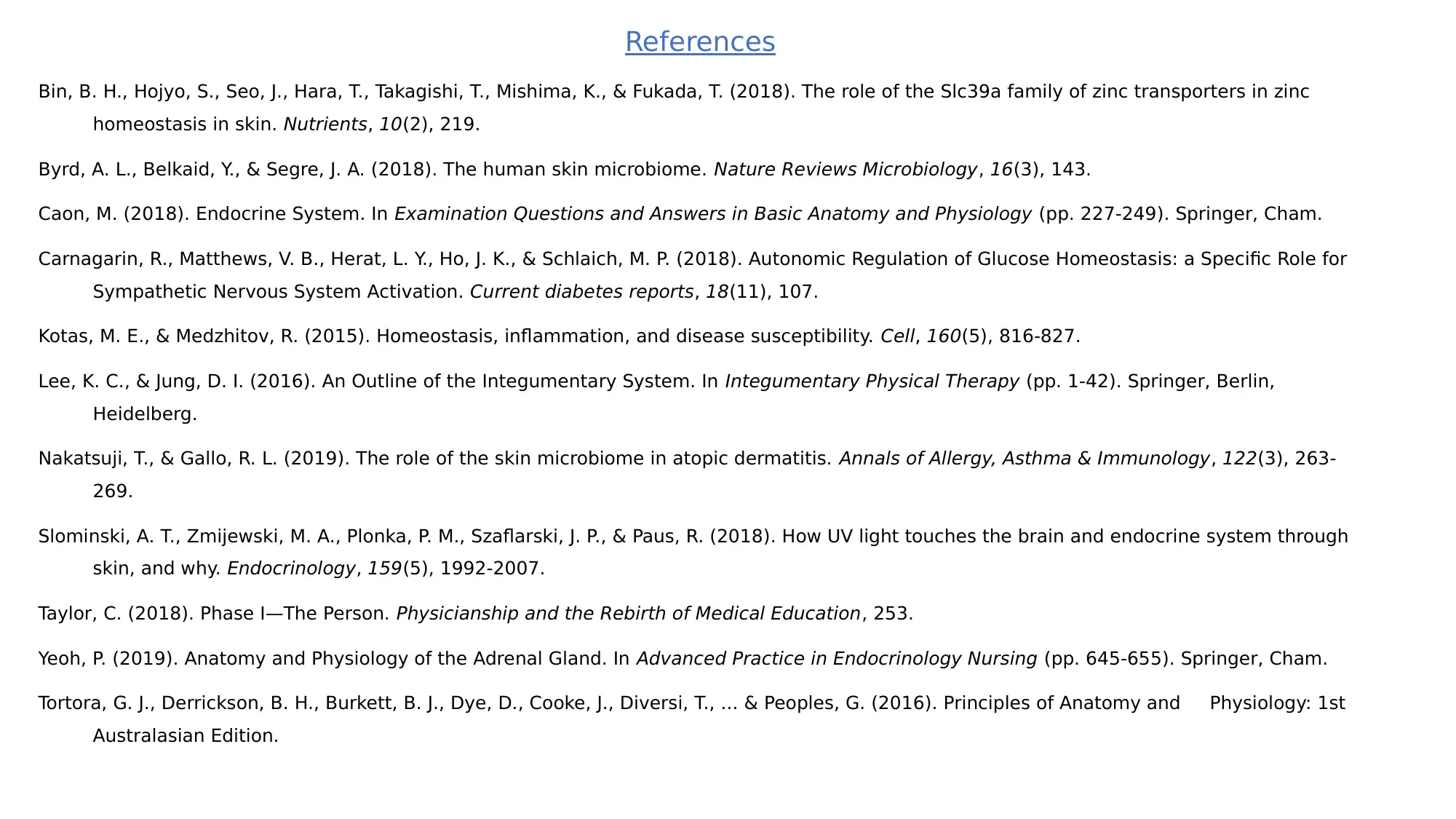
References
Bin, B. H., Hojyo, S., Seo, J., Hara, T., Takagishi, T., Mishima, K., & Fukada, T. (2018). The role of the Slc39a family of zinc transporters in zinc
homeostasis in skin. Nutrients, 10(2), 219.
Byrd, A. L., Belkaid, Y., & Segre, J. A. (2018). The human skin microbiome. Nature Reviews Microbiology, 16(3), 143.
Caon, M. (2018). Endocrine System. In Examination Questions and Answers in Basic Anatomy and Physiology (pp. 227-249). Springer, Cham.
Carnagarin, R., Matthews, V. B., Herat, L. Y., Ho, J. K., & Schlaich, M. P. (2018). Autonomic Regulation of Glucose Homeostasis: a Specific Role for
Sympathetic Nervous System Activation. Current diabetes reports, 18(11), 107.
Kotas, M. E., & Medzhitov, R. (2015). Homeostasis, inflammation, and disease susceptibility. Cell, 160(5), 816-827.
Lee, K. C., & Jung, D. I. (2016). An Outline of the Integumentary System. In Integumentary Physical Therapy (pp. 1-42). Springer, Berlin,
Heidelberg.
Nakatsuji, T., & Gallo, R. L. (2019). The role of the skin microbiome in atopic dermatitis. Annals of Allergy, Asthma & Immunology, 122(3), 263-
269.
Slominski, A. T., Zmijewski, M. A., Plonka, P. M., Szaflarski, J. P., & Paus, R. (2018). How UV light touches the brain and endocrine system through
skin, and why. Endocrinology, 159(5), 1992-2007.
Taylor, C. (2018). Phase I—The Person. Physicianship and the Rebirth of Medical Education, 253.
Yeoh, P. (2019). Anatomy and Physiology of the Adrenal Gland. In Advanced Practice in Endocrinology Nursing (pp. 645-655). Springer, Cham.
Tortora, G. J., Derrickson, B. H., Burkett, B. J., Dye, D., Cooke, J., Diversi, T., ... & Peoples, G. (2016). Principles of Anatomy and Physiology: 1st
Australasian Edition.
Bin, B. H., Hojyo, S., Seo, J., Hara, T., Takagishi, T., Mishima, K., & Fukada, T. (2018). The role of the Slc39a family of zinc transporters in zinc
homeostasis in skin. Nutrients, 10(2), 219.
Byrd, A. L., Belkaid, Y., & Segre, J. A. (2018). The human skin microbiome. Nature Reviews Microbiology, 16(3), 143.
Caon, M. (2018). Endocrine System. In Examination Questions and Answers in Basic Anatomy and Physiology (pp. 227-249). Springer, Cham.
Carnagarin, R., Matthews, V. B., Herat, L. Y., Ho, J. K., & Schlaich, M. P. (2018). Autonomic Regulation of Glucose Homeostasis: a Specific Role for
Sympathetic Nervous System Activation. Current diabetes reports, 18(11), 107.
Kotas, M. E., & Medzhitov, R. (2015). Homeostasis, inflammation, and disease susceptibility. Cell, 160(5), 816-827.
Lee, K. C., & Jung, D. I. (2016). An Outline of the Integumentary System. In Integumentary Physical Therapy (pp. 1-42). Springer, Berlin,
Heidelberg.
Nakatsuji, T., & Gallo, R. L. (2019). The role of the skin microbiome in atopic dermatitis. Annals of Allergy, Asthma & Immunology, 122(3), 263-
269.
Slominski, A. T., Zmijewski, M. A., Plonka, P. M., Szaflarski, J. P., & Paus, R. (2018). How UV light touches the brain and endocrine system through
skin, and why. Endocrinology, 159(5), 1992-2007.
Taylor, C. (2018). Phase I—The Person. Physicianship and the Rebirth of Medical Education, 253.
Yeoh, P. (2019). Anatomy and Physiology of the Adrenal Gland. In Advanced Practice in Endocrinology Nursing (pp. 645-655). Springer, Cham.
Tortora, G. J., Derrickson, B. H., Burkett, B. J., Dye, D., Cooke, J., Diversi, T., ... & Peoples, G. (2016). Principles of Anatomy and Physiology: 1st
Australasian Edition.
⊘ This is a preview!⊘
Do you want full access?
Subscribe today to unlock all pages.

Trusted by 1+ million students worldwide
1 out of 12
Your All-in-One AI-Powered Toolkit for Academic Success.
+13062052269
info@desklib.com
Available 24*7 on WhatsApp / Email
![[object Object]](/_next/static/media/star-bottom.7253800d.svg)
Unlock your academic potential
Copyright © 2020–2025 A2Z Services. All Rights Reserved. Developed and managed by ZUCOL.
